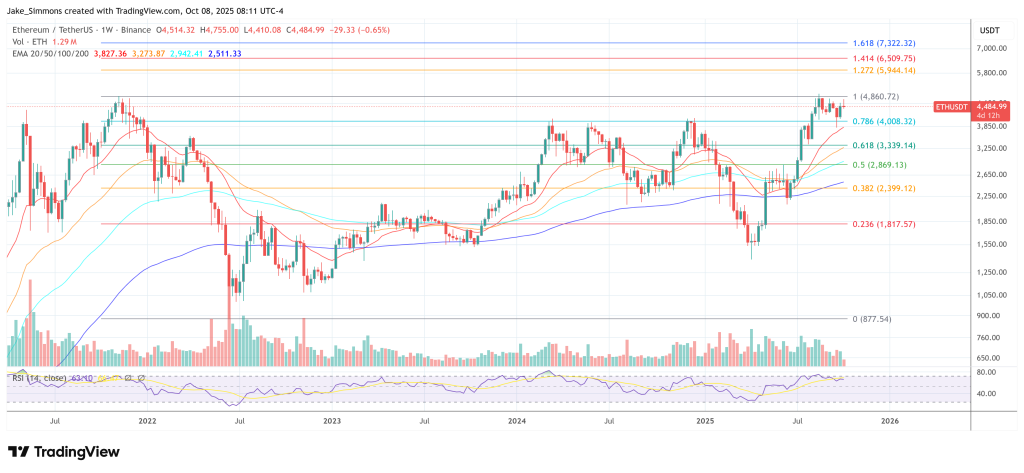
Ethereum co-founder and ConsenSys head Joseph Lubin appeared on Bloomberg Crypto on October 7 and confirmed that ConsenSys is building the prototype of SWIFT’s new blockchain-based shared ledger – an initiative that, according to SWIFT’s announcement last week at Sibos in Frankfurt, will integrate a permissioned, always-on ledger into the infrastructure of the global messaging cooperative and will natively integrate the ISO 20022 financial standards. messaging.
SWIFT builds on Ethereum
Lubin said the first version “will most certainly implement messaging, financial messaging using the ISO 20022 standard,” adding that while SWIFT itself is “making sure to stay in its lane and focus on the messaging part,” some participating banks are “interested in potentially diving into the settlement layers.”
“I have to be careful what I say. This is a project that we are building. There will be technologists on their side and a lot on our side. And I’m glad you called it a prototype, because that’s what it is,” the ConsenSys founder added.
He declined to give a deployment timetable. “I have an idea of what kind of timeline it is, and I can’t say much about it. We define what we think is the end state, and we go back to that, so I don’t know if SWIFT will be comfortable releasing the timeline at this point,” Lubin said.
SWIFT’s project, explicitly presented as a shared ledger that records, sequences and validates transactions, was unveiled on September 29, with the cooperative emphasizing that the project aims to achieve instant, 24/7 cross-border transactions on a global scale and accelerate “the transition to digital finance” while remaining asset agnostic and interoperable with public networks and private. The formal documents did not name a base chain, but they named ConsenSys as the lead technology partner and emphasized ISO 20022 compliance and business rules enforced by smart contracts.
In his Bloomberg interview, Lubin highlighted a broader strategic shift: the long-standing separation between “TradFi” and “DeFi” is crumbling. “Since the launch of Ethereum, we had to stay on our own path… the mood in Frankfurt was very different,” he said, describing the overwhelmingly positive feedback from banks and calling “it’s time for TradFi to merge or use DeFi.” He also called the current version a true prototype with technologists “on their side and a lot on our side,” reiterating that SWIFT would control the reach of messaging while banks explore deeper layers like atomic settlement.
What “using Ethereum” means in practice
Although SWIFT has not officially specified the underlying chain in its press releases, several industry reports following Sibos and Lubin’s subsequent public remarks indicate that the prototype will run on Ethereum infrastructure, specifically ConsenSys’ Linea, a Layer 2 Ethereum network that uses zero-knowledge proofs, positioning the build within the Ethereum ecosystem while maintaining an authorized perimeter consistent with bank compliance requirements. This report is consistent with ConsenSys’ own statement that it is “supporting Swift with early prototyping” for the shared ledger.
The institutional context is important. SWIFT’s ledger initiative comes amid rapid growth in the $300 billion stablecoin market and a wave of banking tokenization pilots; its stated design goal is to extend existing rails rather than replace them, allowing banks to opt for tokenized processes where it improves speed, transparency and finality.
Beyond SWIFT: Lubin’s thesis on treasury
Lubin also used the Bloomberg segment to discuss the rise of “digital asset-backed treasures” (DATs) such as the Ethereum-focused vehicle he chairs at SharpLink. He argued that corporate accumulation of ether is a “volatility dampener”, describing ether as a “productive and productive asset unlike bitcoin” when staked, and describing a Berkshire-style flywheel in which a growing base of ETH is deployed across Ethereum-aligned protocols for non-dilutive growth.
The strategic throughline is clear: if financial incumbents standardize on Ethereum-based rails for messaging and, increasingly, settlement, balance sheet ETH becomes a strategic asset for institutions seeking exposure to network activity and performance.
At press time, ETH was trading at $4,484.

Featured image created with DALL.E, chart from TradingView.com

Editorial process as Bitcoinist focuses on providing thoroughly researched, accurate and unbiased content. We follow strict sourcing standards and every page undergoes careful review by our team of top technology experts and seasoned editors. This process ensures the integrity, relevance and value of our content to our readers.




